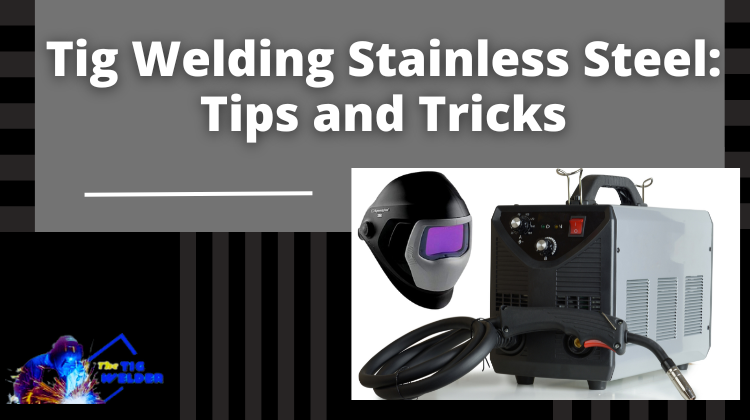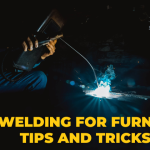TIG welding, also known as gas tungsten arc welding (GTAW), is a popular method that uses a non-consumable tungsten electrode to produce the weld. TIG welding is known for producing high-quality welds with a clean and visually appealing appearance, making it an ideal choice for various industries, including aerospace, automotive, and construction.
One of the key benefits of TIG welding is the ability to produce precise and controlled welds, which can be especially important in industries where the welds must withstand extreme stress or meet strict aesthetic standards. Additionally, TIG welding allows a wider range of material thicknesses to be welded compared to other methods, making it a versatile choice for many applications.

Best Tig Welding Stainless Steel Tips and Tricks
To maximize the potential of your TIG welder, it’s important to have a solid understanding of the basic techniques and be familiar with some advanced techniques that can help you produce even higher-quality welds. This article will cover basic and advanced TIG welding techniques to help you take your skills to the next level.
Basic Tig Welding Techniques
Before diving into advanced TIG welding techniques, it’s important to first understand the basic techniques. Here are some key points to keep in mind when setting up your equipment and preparing to TIG weld:
- Setting up the equipment: Ensure you have all the necessary equipment and supplies, including the TIG welder, a TIG torch, a ground clamp, and a filler metal. It’s also important to set the welder to the appropriate amperage and choose the right size and type of tungsten electrode based on the material you’ll be welding and the thickness of the workpiece.
- Choosing the right filler metal: Selecting the right filler metal is important to ensure that you have the proper strength and compatibility with the base material. Consider the material’s thickness, the weld’s desired strength, and any special requirements (such as corrosion resistance) when choosing the filler metal.
- Prepping the workpiece: Proper preparation of the workpiece is crucial for producing a high-quality weld. This includes cleaning the surface of any contaminants or debris, properly aligning the workpiece, and using clamping or tack welding to hold the pieces.
- Striking an arc: Striking an arc is starting the weld. You’ll need to hold the TIG torch a short distance from the workpiece and touch the tungsten electrode to the workpiece to initiate the arc. Maintaining a consistent distance between the electrode and the workpiece is important to ensure a stable arc.
- Maintaining the arc: Once the arc is established, you’ll need to maintain a consistent distance and angle between the TIG torch and the workpiece. This will help ensure a smooth and even weld bead.
- Welding in different positions: TIG welding can be done in various positions, including flat, horizontal, vertical, and overhead. It’s important to practice proper body positioning and grip to maintain control of the torch and produce a high-quality weld.
Advanced Tig Welding Techniques
Once you understand the basic TIG welding techniques, you can explore some advanced techniques that can help you take your skills to the next level. Here are a few advanced techniques to consider:
- Backgassing: Backgassing involves purging the weld area with an inert gas (such as argon) to prevent contamination from the atmosphere. This can be especially important when welding materials, such as aluminum, that are prone to oxidization. Backgassing can help produce a cleaner and stronger weld by preventing the formation of oxides on the surface of the workpiece.
- Pulse welding: Pulse welding involves rapidly switching the welder’s amperage between high and low levels during the weld. This technique can reduce heat input and minimize distortion, making it useful for welding thin materials or welding in tight spaces.
- Hot-start techniques: Hot-start techniques involve increasing the amperage at the weld’s start to help initiate the arc and establish a strong root pass. This can be especially useful when welding materials with high resistance, such as stainless steel.
- Cold-wire techniques: Cold-wire techniques involve adding a continuous feed of filler metal to the weld puddle while TIG welding. This can help improve weld speed and consistency and reduce the amount of heat input into the workpiece.
- Multi-pass welding: Multi-pass welding involves building up the weld bead in multiple layers rather than trying to complete the weld in a single pass. This technique can be useful for welding thick materials or producing stronger welds.
Tips For Maximizing Tig Welding Efficiency
In addition to learning and practicing advanced TIG welding techniques, there are a few other tips you can follow to help maximize the efficiency and effectiveness of your TIG welder:
- Properly maintaining and cleaning equipment: Regular maintenance and cleaning of your TIG welder and other equipment is crucial to ensure that it is functioning properly and producing high-quality welds. This includes cleaning the tungsten electrode, replacing consumable parts as needed, and properly storing the equipment when not used.
- Using the right shielding gas: The type of shielding gas you use can significantly impact the quality of your welds. Ensure you use the appropriate gas for the material you are welding and the welding conditions.
- Properly storing filler metal: Filler metal can become contaminated if not stored properly, affecting the quality of your welds. Make sure to store filler metal in a dry, clean location to help prevent contamination.
- Practicing proper body positioning and grip: Proper body positioning and grip can help you maintain control of the TIG torch and produce a high-quality weld. Make sure you are comfortable and have a stable footing while welding, and hold the torch at a comfortable angle to help minimize fatigue.
FAQ’s
What Settings Do I Use To Tig Weld Stainless Steel?
To TIG weld stainless steel, you will need to use a constant current (CC) welding machine, also known as a DC power source. This power source maintains a constant welding current, which is important for producing a stable arc and high-quality welds.
You will also need to set the welding current (amperage) according to the thickness of the stainless steel you are welding. A good starting point for welding stainless steel is 20-30 amps for thin sheets, 40-80 amps for thicker sheets, and 80-120 amps for pipes or thicker materials. It’s important to use the appropriate amperage for the thickness of the material to avoid overheating and warping the metal.
It would help if you also used a high-frequency (HF) start to initiate the arc. This helps to stabilize the arc and reduce contamination of the weld pool.
Finally, you will need to set the welding speed according to the thickness of the material. A slower speed is generally recommended for thicker materials, while a faster speed is better for thin materials.
What Polarity Do You Tig Weld Stainless On?
For TIG welding stainless steel, you should use direct current electrode negative (DCEN), also known as straight polarity. This means that the tungsten electrode is connected to the negative terminal of the welding power source, and the workpiece is connected to the positive terminal.
What Amperage Is Best For Tig Welding Stainless Steel?
The best amperage for TIG welding stainless steel depends on the thickness of the material. A good starting point is 20-30 amps for thin sheets, 40-80 amps for thicker sheets, and 80-120 amps for pipes or thicker materials. It’s important to use the appropriate amperage for the thickness of the material to avoid overheating and warping the metal.
What Color Tungsten For Stainless Steel?
For TIG welding stainless steel, you should use a green tungsten electrode. This type of tungsten has a higher purity and a lower amount of contaminants, which helps to produce a cleaner weld.
It’s important to note that these are just general guidelines, and the specific settings and procedures you use may vary depending on the type and thickness of the stainless steel you are welding and your welding style and technique. It’s always a good idea to refer to the manufacturer’s instructions for your welding machine and follow proper safety guidelines when welding.
Do you push or pull TIG stainless?
TIG welding (Tungsten Inert Gas) is a type of welding process that uses a non-consumable tungsten electrode to produce the weld.
When it comes to welding stainless steel using TIG welding, the welding torch should always be moved in a pulling motion rather than a pushing motion. The reason for this is that the pulling motion allows the shielding gas to flow over the weld pool and protect the molten metal from oxidation, which could result in a weaker and more porous weld.
So, to answer your question, you should always pull the TIG welding torch when welding stainless steel.
Conclusion
TIG welding is a versatile and precise welding method that is widely used in a variety of industries. By learning and practicing basic and advanced TIG welding techniques, you can maximize the potential of your TIG welder and produce high-quality welds. In addition, maintaining and properly using your equipment, selecting the right shielding gas, and practicing proper body positioning and grip can all help you improve your TIG welding efficiency. Continual learning and practice are important to help you improve your TIG welding skills and take your career to the next level.

It’s been years since I got into welding as a side hustle. It’s been so long since Doing All kinds of welds for business and pleasure as this is my hobby. Being in this field I have learned from hands-on-experience also came to know what gears work and what doesn’t. The Tig Welder is my own platform where I use to share my experience.






Leave a Reply